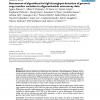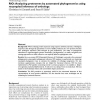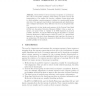192 search results - page 34 / 39 » Genome rearrangements with duplications |
BMCBI
2007
14 years 12 months ago
2007
Background: Genomic deletions and duplications are important in the pathogenesis of diseases, such as cancer and mental retardation, and have recently been shown to occur frequent...
109
click to vote
BMCBI
2002
14 years 11 months ago
2002
Background: When analyzing protein sequences using sequence similarity searches, orthologous sequences (that diverged by speciation) are more reliable predictors of a new protein&...
COMPLIFE
2005
Springer
15 years 5 months ago
2005
Springer
Abstract. Most software tools in homology recognition on proteins answer only a few specific questions, often leaving not much room for the interpretation of the results. We devel...
126
click to vote
GECCO
1999
Springer
15 years 4 months ago
1999
Springer
This paper discusses the simulation results of a model of biological development for neural networks based on a regulatory genome. The model’s results are analyzed using the fra...
BMCBI
2010
14 years 12 months ago
2010
Background: Most known eukaryotic genomes contain mobile copied elements called transposable elements. In some species, these elements account for the majority of the genome seque...




